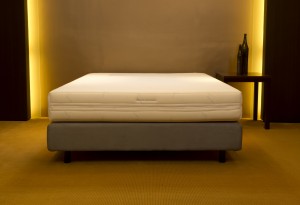You’ve probably heard of this before: gadgets can keep you up at night and make it difficult for you to tune out. The light emitted by electronic devices such as smartphones, tablets, and laptops, signal the brain to stay awake. According to the National Sleep Foundation, photoreceptors in the retina sense light and dark, signaling the brain about the environment and then aligning it with a person’s circadian rhythm. Thus, the continued exposure of the eyes to a gadget’s light messes up with the photoreceptors’ ability to send the right signals to the brain.
This is the primary reason why turning off electronic devices and staying away from them at least an hour before you hit the sack always make it on the list of tips to help people sleep. But what if technology can also help you sleep better? Will you buy it?
Yes, you read that right. In today’s continuously evolving technology, there’s actually no reason for you to doubt that possibility. And for a change, this article will not tell you about the negative connection between technology and sleep but rather, how different sleep technology and innovations can help you love sleep more and finally get rid of sleepless nights.
- Stay on Track with Sleep Trackers
Knowing your sleep patterns can play a huge role in improving sleep itself, and reverse and eliminate possible causes of sleep problems. Among the data you will need to keep track of are pre-bedtime activities, how many hours of shuteye you usually you get every night, and at which times are you most restless. Currently, the best way to acquire these information is through the help of sleep trackers.
Sleep trackers come in different forms. Many smartwatches and fitness trackers like FitBit products are equipped with sleep monitoring features. Meanwhile, if you’re not used to wearing something on your wrist while sleeping, you can opt for sleep monitors that can be put under and inside bed mattresses, an example of which is Beddit. Ironic as it may sound, there are also sleep tracking apps for smartphones.
- Wrap It Up
Gone are the days when headbands were only used to keep stubborn bangs in place. One of the newest innovation in sleep technology is sleep-tracking headbands. These also work as sleep trackers but they also double as a drug-free sleep assistant. When wrapped around your head, a sleep headband collects data about your sleep patterns and use them to improve your rest. They are designed to play subtle humming noises that can lull your brain to fall into deep sleep, the most important part of the sleep cycle.
- Bluer than Blue: Blue Light Adjusting Software
Using your personal computer or laptop until late at night can mess up your sleeping patterns big time. Light-emitting devices generate blue light that basically mimics the brightness of the sun. As mentioned earlier, the light coming from electronic devices affects the brain’s ability to shut down, and can also cause eye strain. Thankfully, there are now programs that can automatically change the color and brightness of a computer’s monitor, eventually removing blue light later in the day. Similar technology is already being adopted by the mobile device industry, with Apple taking the lead through their iPhone feature Night Shift.
- Get Your Game On
The need for technologies for people who love to sleep and hoping to get more of it has also encouraged major players in the gaming industry to develop their own systems. Nintendo, in particular, has patented their own sleep monitor, a sensor-laden alarm clock-like device equipped with a projector. The system is said to collect and assess a user’s emotional state during sleep and then calculate their sleep score, which will later be projected on the wall or ceiling. Futuristic, isn’t it?
- Plug It In
Music has an ability to help some people fall asleep. However, today, most people use their electronic devices to store and play music. This makes the process counterproductive, since the goal is to eliminate the use of gadgets before sleeping. To take advantage of music and sound’s power to induce sleep sans the utilization of light-emitting electronics, earplugs that produce soothing sounds and mask unwanted noises are now made available on the market.
- All-in-One Sleep Systems
Wondering if there’s a device that can do it all, from tracking sleeping patterns to playing soothing sounds, and maybe more? There are all-in-one sleep systems available. As mentioned, they can track your sleep and improve your rest through a variety of features, such as playing soothing sounds and using calming lights. Some systems can also wake you up gently. More advanced systems can also monitor your bedroom’s temperature, ambient noise, and humidity to make sure that they are just right for achieving quality rest and sleep.
- Technology-Enhanced Mattresses

Photo courtesy of Uratex Foam Philippines
We’ve all had our share of sleepless nights, tossing and turning in bed, and exhausted mornings. But did you know that sleeping on the right mattress can eliminate this problem? According to a study by Research Triangle International and Drs. Andy Krystal and Jack Edinger of Duke University, even small differences in mattress support can affect one’s quality of sleep. Fortunately, today’s various forms of foam technology make for enhanced style and design while providing ultimate comfort and body support. Memory foam mattresses that follow the natural contour of the body and provide just the right amount of support is a prime example of modern bed mattress technology. Furthermore, there are also mattresses that use smart fabric and sensors designed to automatically inflate and deflate in the middle of the night to conform to your body’s pressure.
- Spray Away
Sleep sprays may sound like something someone with a bad intention would use, but we are talking about sleep sprays designed to emulate the body’s natural melatonin production. Instead of taking melatonin pills, these sprays bypass the digestive system, making them a more natural option than the chemically-derived melatonin supplements.
- The Power of 3D
Sufferers of sleep apnea are made to wear CPAP masks to normalize airflow during sleep. While the treatment works well, we cannot discount the fact that these masks may become annoying to wear. To address this issue, 3D printing is now being used to create adaptors contoured according to a user’s face structure. These adaptors are put under CPAP masks, providing better comfort throughout the night.
By combining these technologies with sleep specialist- and expert-proven tricks to sleep better and earlier, you and your family will finally be able to get the much needed adequate and quality rest to stay healthy physically, mentally, and emotionally.


